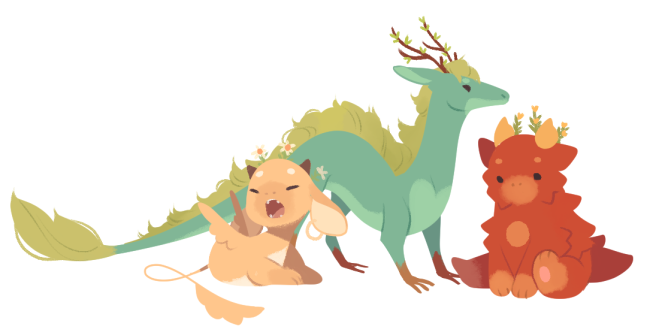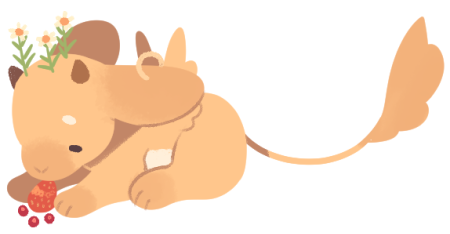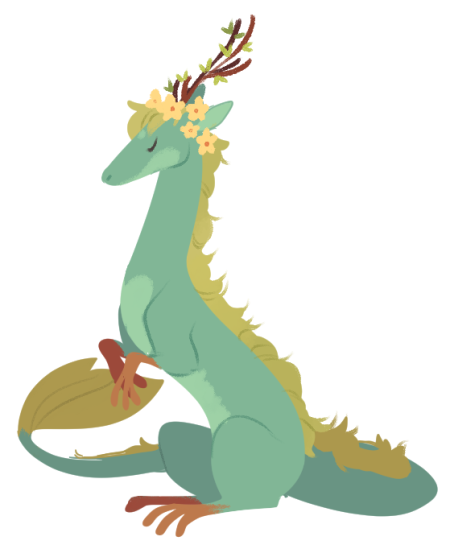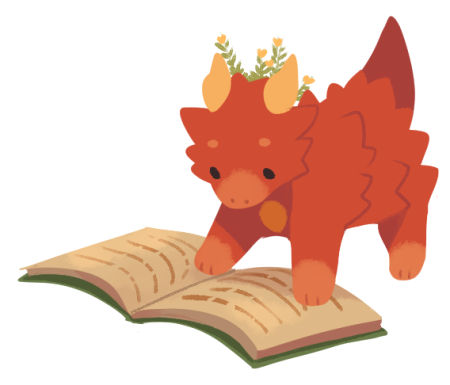ALMANAC
Tea dragons are smallest and only domesticated subspecies of the dragon genus. They were bred by Sylkes from abandoned runt offspring of a small dragon species thousands of years ago, using herbs and spells to shrink their size and infuse them with plants. *There are about a dozen different dragon subspecies, ranging from tea dragons which are the least clever and wild, to full-grown, highly intelligent and cultured creatures who can shapeshift and often live amongst other race’s societies with an elevated/revered/fearsome social status.

Tea dragons live for between five-hundred and a thousand years, depending on how well their owner takes care of them – or rather, their multiple owners, as even Sylkes do not live as long as tea dragons do, and must therefore pass them along to a new caretaker. They reach full size after about fifty years, and after that do not grow any larger (though their horns and claws will, so they need to be carefully trimmed on a regular basis).
Because of their heavy domestication process, tea dragons have lost all survival instincts, and if anything have become much worse at surviving. They are finicky and particular, and everything must be done in the correct way for them to be satisfied. Some argue that the benefits of a tea dragon do not outweigh the difficulties of caring for them, but their avid devotees would disagree, citing the strong and loyal bond that they have with their owners, as well as the enchanted properties of their tea.
![]()
Diet
Tea dragons eat a staple diet of root vegetables, insects and fruit. They can be fed herbs and vegetables flavoured with spices in order to enhance and accent the flavour of their tea. Each tea dragon has a different eating schedule, can only be discovered through trial and error. They must be fed at exactly the right time, or they will be affronted and refuse to eat at all that day.

Some tea dragon owners spoil their dragon with sugary snacks. This is not advised, as it puts the dragons into a very bad mood. For tea dragons treats, extra-ripe fruits and baked vegetables such as pumpkin or squash are the best choice.
Tea dragons are lactose intolerant.
![]()
Grooming
Grooming is an essential part of tea dragon husbandry, not only to keep them in top condition, but also because they are very vain and like to feel superior to other tea dragons. Most tea dragons are covered in short fur, and some may have longer manes. This needs to be rubbed once daily with a soft brush to help produce and distribute natural oils. The mane can be brushed with a fine-tooth comb.

Tea dragons do not like bathing. This is usually fine as they do not like getting dirty either. However if it’s necessary to clean a tea dragon, they need to be washed at a warm hearth with water just above their body temperature. They are very modest and no-one but their owner can see them while they bathe, even though they aren’t wearing clothes the rest of the time anyway.
For extra gloss, natural oils such as almond or milkflower extract can be rubbed through the fur.
![]()
Activity
Tea dragons do not require play, they require entertainment. Tea dragons are proud and will not actively engage themselves in activities unless tricked into it.

The good news is that tea dragons are immensely curious and nosy, and following their owner around as they perform daily tasks such as cooking, cleaning or going to the market, is usually sufficiently entertaining. The bond between them quickly becomes mutual, and for most owners it’s hard to imagine going about everyday life without a sniffling inquisitive nose poking into their business.
![]()
Breeding
Tea dragon breeding is a very deliberate process, and done very rarely. Anyone who has cared for tea dragons knows how much devotion they require, and would not breed them lightly as they need to be found a dedicated owner. If breeding is desired, the offspring’s tea variety will be a combination of the parent’s teas. Though a few people have experimented with different combinations, each type of tea leaf needs to be grown, harvested and prepared in a different way. Therefore it’s generally considered better to keep each dragon as a purebred tea variety, and then mix dried leaves afterwards if desired.

